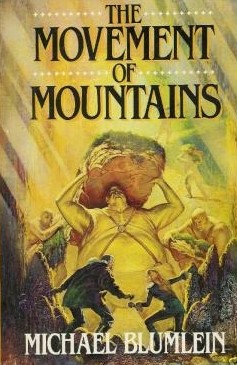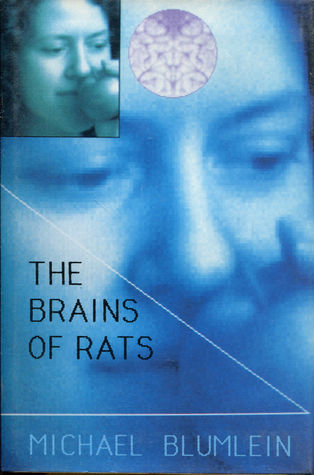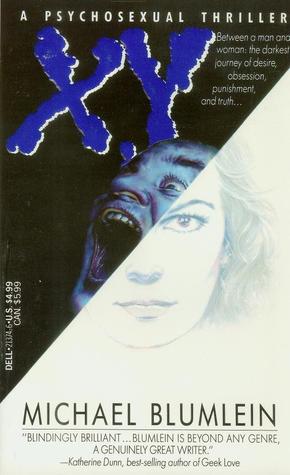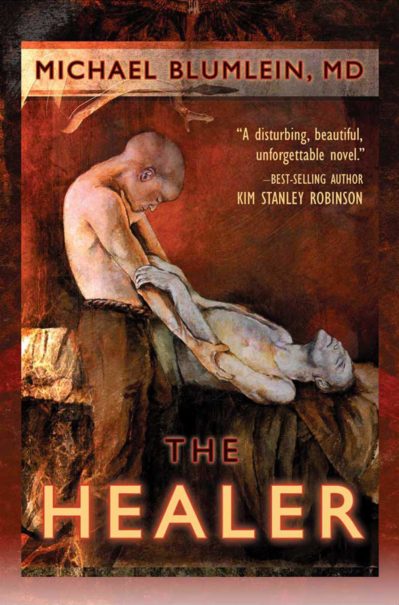Michael Blumlein, a San Francisco-based doctor, is one of the most distinctive horror/sci fi writers on the scene, as evinced by three absolutely stunning novels and an equally dazzling short story collection. Blumlein’s writing is distinguished by unnervingly calm, clinical prose as distinct as that of nearly any writer you can think of, and an outlook that can only be called profoundly strange—note the pointed and precise biography he provides on michaelblumlein.com (“I was born and raised in San Francisco. My father was a grocer and a card player. My mother loved books”), a potent example of his inimitable style.
Now here’s the bad news: the three novels and single collection mentioned above are (as of 2008) the only books Blumlein has published in a career that spans over twenty years (I’m guessing his day job is keeping him plenty busy). That’s our loss, although what he accomplished with those books is more than most other writers can ever hope to achieve.
 Blumlein exploded onto the scene with THE MOVEMENT OF MOUNTAINS, published by St. Martin’s Press in 1987. It was packaged as straight science fiction, although the back cover blurbs by John Shirley, K.W. Jeter and Rudy Rucker (sci fi’s very own Whack Pack) should have tipped off cannier readers as to the book’s much weirder charms. It’s a fully assured, poised and confident debut novel with real style and vision.
Blumlein exploded onto the scene with THE MOVEMENT OF MOUNTAINS, published by St. Martin’s Press in 1987. It was packaged as straight science fiction, although the back cover blurbs by John Shirley, K.W. Jeter and Rudy Rucker (sci fi’s very own Whack Pack) should have tipped off cannier readers as to the book’s much weirder charms. It’s a fully assured, poised and confident debut novel with real style and vision.
It’s about a race of humanoid mutants called Domers, genetically engineered to harvest a fungus on a distant planet. Said fungus is the only known cure for a sexually transmitted disease that has all but ravaged the human race. The novel’s wonderfully quirky hero, an overweight doctor, must make a choice whether to save the Domers or humanity, which is in the grip of a new, even deadlier disease.
Of course the story is a fairly standard sci fi account, complete with an ethical message, but it’s filtered through Blumlein’s peerlessly disturbed imagination. What emerges is a rich and strange concoction that grows increasingly hallucinatory. But in truth the book is terminally nuts from the opening sequence, in which a man informs the hero that he has a sore on his penis. This adequately sets the tone for a novel that often reads like the testimony of deranged MD with a chip on his shoulder.
THE BRAINS OF RATS, a Scream/Press issued collection, followed in 1990. It’s often difficult figuring out what Blumlein was trying to say with some of  the stories herein, or at times what the damn things are even about, but they’re all fascinating and compelling works of pure imagination.
the stories herein, or at times what the damn things are even about, but they’re all fascinating and compelling works of pure imagination.
Particularly noteworthy is the title story, which examines, in deliberately clinical fashion, the true differences between male and female. “The Wet Suit” is another stand-out, being an examination of the implosion of a family in the wake of the discovery of what their deceased patriarch did in his spare time. “A Promise of Warmth” is about a dude turning into a lizard.
Then there’s “The Thing Itself,” a real head-scratcher involving a star-crossed romance between an ailing physician and one of his patients that incorporates angels, demons, and a startlingly ambitious examination of nothing less than life and death. “Bestseller,” which closes out the collection, is a lengthy piece about a poverty stricken man’s ill-advised decision to sell pieces of himself to a decaying rich guy. The psychic interplay between the two characters, one of them inheriting the limbs, tissues and organs of the other, is perfectly delineated, as is the upheaval it causes in the protagonist’s life.
Those desiring weirdness and pure imaginative brilliance are strongly advised to track down THE BRAINS OF RATS, which was issued as a mass market paperback in 1997 by Dell. It’s a stand-out volume in a career that grows stronger with each succeeding book.
 That rule held true with 1993’s X,Y, Blumlein’s first-ever paperback original (from Dell’s short-lived Abyss series, which turned out some pretty amazing work). It’s a profoundly disturbing exploration of male-female relations that makes THE CRYING GAME look like SESAME STREET.
That rule held true with 1993’s X,Y, Blumlein’s first-ever paperback original (from Dell’s short-lived Abyss series, which turned out some pretty amazing work). It’s a profoundly disturbing exploration of male-female relations that makes THE CRYING GAME look like SESAME STREET.
After undergoing a protracted seizure, erotic dancer Frankie wakes up thinking she’s a man, apparently having swapped genders with a patron. Blumlein’s concentration, however, is on Frankie’s relationship with her live-in boyfriend Terry. At first Terry thinks Frankie’s joking around, but soon realizes that things have irrevocably changed in their once idyllic romance, leading to some seriously twisted mind games that devolve into out-and-out S&M as Frankie realizes the power wielded by female sexuality and uses it to her advantage.
Interspaced with nonfiction excerpts outlining the story’s real-life psychosexual parallels, it’s an unputdownable classic, but also a decidedly twisted one. Many readers will doubtless view X,Y as a pointless exercise in psychosexual grotesquerie, while others (particularly this one) will find it a brave and unflinching peek into the darkest depths of sex, love and everything in between.
Continuing Blumlein’s trend of getting better with each book (and taking ever-longer to crank them out),  THE HEALER, which appeared in 2005, is his strongest work to date. In contrast to the others it’s a more or less straightforward sci fi novel, perhaps an attempt at a mainstream bestseller. If that was indeed Blumlein’s intent then he failed, as the novel was published in hardcover by the independent imprint Prometheus Books, and never made it into the chain bookstores. That’s a shame, as THE HEALER is stunner: endlessly imaginative, absorbing and even profound.
THE HEALER, which appeared in 2005, is his strongest work to date. In contrast to the others it’s a more or less straightforward sci fi novel, perhaps an attempt at a mainstream bestseller. If that was indeed Blumlein’s intent then he failed, as the novel was published in hardcover by the independent imprint Prometheus Books, and never made it into the chain bookstores. That’s a shame, as THE HEALER is stunner: endlessly imaginative, absorbing and even profound.
It concerns a race of “Grotesques,” or Tesques, who are afflicted with the “gift” of healing and its attendant responsibilities and consequences. The main character is Payne, a Tesque snatched from his family as a teenager and sent to work as a healer in a remote mining community. There he learns a number of harsh lessons, such as the fact that healers are treated as little more than slaves by humans, and that some folks don’t want to be healed.
From there Payne is shipped to a gambling mecca—a bit like Las Vegas times a thousand–where he joins a band of revolutionary Tesques. He ends up in a government compound where he’s put to work performing the most difficult healings there are. Payne also meets his long-lost brother, who it turns out is wasting away from a weird disease. The problem is that Tesques can’t heal each other…but that doesn’t stop Payne from trying, with unexpected consequences.
Obviously Blumlein, who in this book added an M.D. to his moniker, means to symbolically explore people’s attitudes to doctors, and does so in a wholly fascinating manner. HEALER is an eye-opening, mind expanding piece of work that, despite the fact that the author’s gruesome imagination is fully in evidence, seems ideally suited to reach a wider audience than the previous books—which, alas, it didn’t achieve.
As a postscript, I’ll add a short account of Blumlein’s film work, or “Michael Blumlein at the Movies.” Blumlein provided text for the 1988 short “Decodings,” said to consist of “archival footage that explores the problems of growing up gay in the 1950s and 1960s.” I haven’t seen that film, but have viewed director Stephen Berkman’s “Shape without Form” (included in the 1999 compilation DVD SHORT 1: INVENTION), for which Blumlein shares scripting credit. It’s a determinedly experimental 4-minute swirl of disconnected images set to equally cryptic narration. Make of it what you will—I, while impressed by the undeniable skill with which the film was made, found it off-putting and forgettable.
Finally there’s director Vladimir Vitkin’s feature adaptation of X,Y. It has yet to be commercially released, but is a daring and powerful account, a rare film that actually matches its source novel’s verve and perversity. In other words, if X,Y the book sounds interesting to you, you’ll very likely enjoy the movie.
